A Product Manager’s Roadmap To A Successful Scrum Meeting
Scrum is known for streamlining product development by breaking up large processes into smaller ones. It isn’t the most complicated framework you may encounter but it involves several unfamiliar terminologies. One such term is “scrum meeting.”
A scrum meeting is a term you’ll find to be commonly used when using the Scrum framework. And while it may seem simple enough, it is more extensive than you’d think.
This article will discuss what a scrum meeting entails, how it is conducted, its benefits, different types, and more. Let’s start with a brief definition of the term.
Table of Contents
- What is a scrum meeting?
- What are the different types of scrum meetings?
- Who attends a scrum meeting?
- How are scrum meetings conducted?
- What is the expected outcome of a scrum meeting?
- How often should you conduct scrum meetings?
- 5 tips for better scrum meetings
- 4 common mistakes to avoid during scrum meetings
- Wrapping up: scrum meeting
- Machine Learning In Finance: 12 Essential Applications
- How To Create Interactive Compliance Training For Bank Employees
- How Fintech Apps Are Using Gamification To Increase User Engagement
- Top Gamification Companies for Employee & Customer Engagement
What is a scrum meeting?

A scrum meeting is a general term scrum teams use to refer to any meetings they hold.
Meetings, in this context, are activities which require your team to gather and work together. Though some meetings have specific purposes, all of them will have similar goals:
- To keep everyone up-to-date with changes in the project.
- To gather valuable insights or input from relevant individuals or groups.
- To ensure everyone is on the same page.
Everyone here means the scrum team and the stakeholders.
Scrum meetings are particularly crucial since scrum often involves incremental changes.
The team holds these regularly and schedules them beforehand. That’s why you may have to include the schedules of these meetings in product requirements documents.
Since a scrum meeting refers to various activities, it has different types.
What are the different types of scrum meetings?
Most agile teams categorise scrum meetings into five, three related to sprints.
For reference, a sprint is a period of time, typically one to four weeks, where the team must complete a set amount of work. This “work” is typically in the form of a product increment.
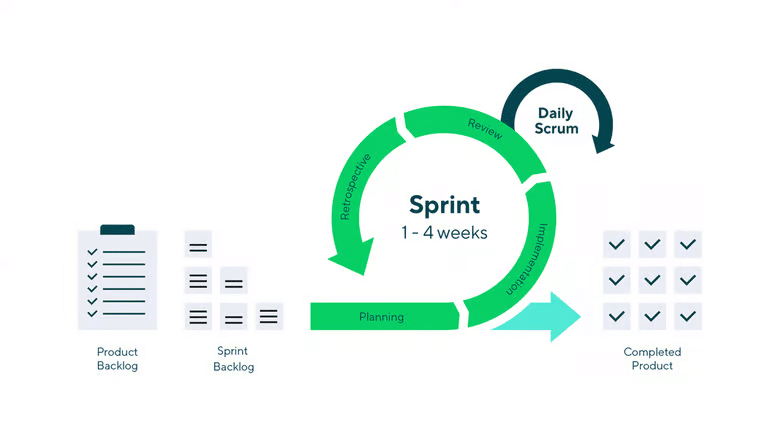
Source: wrike
The different types of meetings vary in several ways, such as:
- Their purpose.
- The required participants and their roles.
- How they are conducted.
- The expected outcomes.
- Their typical schedule (duration and frequency).
As such, there is a need for product managers to distinguish between them.
Here’s an overview of what each type of scrum meeting entails.
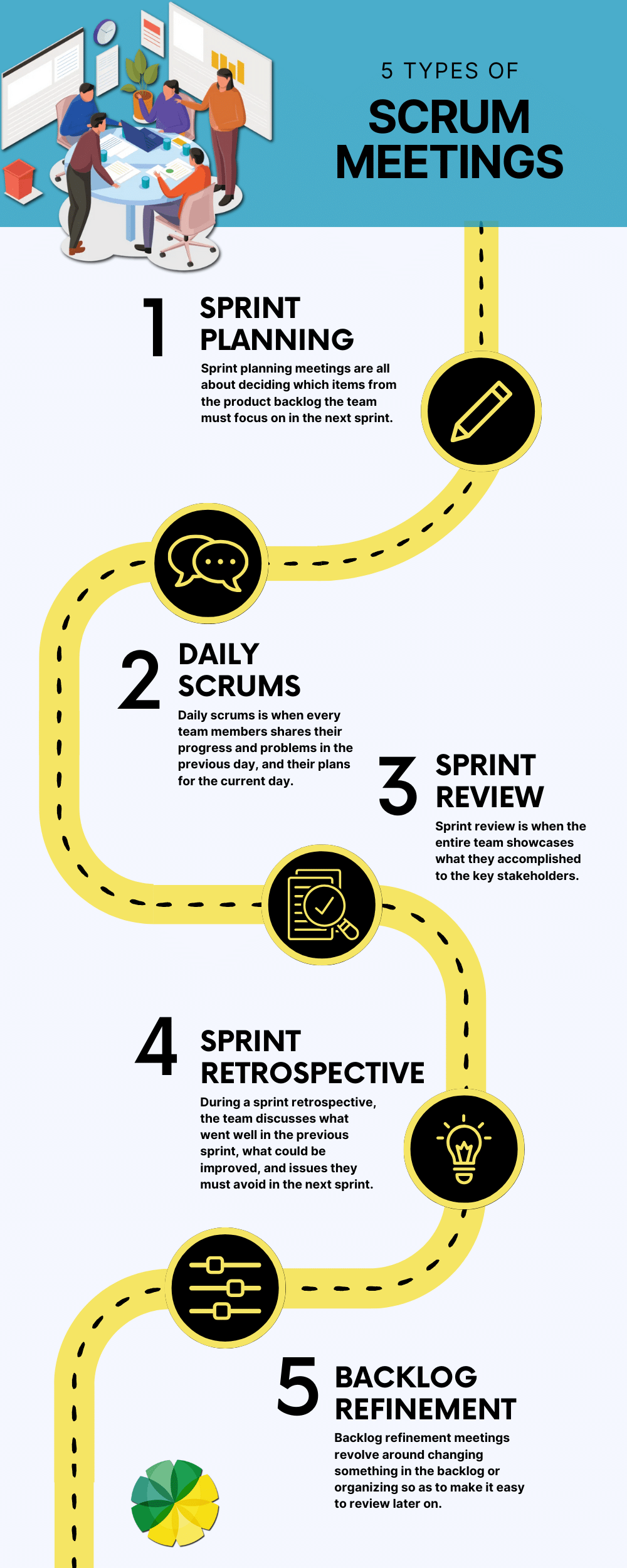
#1. Sprint planning
Sprint planning is when the agile team discusses what needs to be accomplished. You must decide what tasks your team must commit to in your upcoming sprint.
That means sprint planning is a type of scrum meeting conducted once every sprint, specifically before it begins. Note that sprints usually last for one to four weeks.
Its main purpose is to create a common goal, a.k.a. a sprint goal, among all team members.
This “goal” comes in the form of the sprint backlog—one of the scrum artefacts. It consists of items from the product backlog that must be completed during the current sprint.
#2. Daily scrum/standup
Daily scrums, also known as daily standups, are meetings conducted during a sprint. It is held every day, usually when the day starts before the team works on their assigned tasks.
Team members share their plans, progress, and obstacles during such meetings. It gives them an understanding of how everyone’s doing and their task progress.
#3. Sprint review
A sprint review is the opposite of sprint planning. It’s a meeting conducted at the end of every sprint where team members must discuss the work or tasks they have completed.
It is a way to keep the stakeholders up-to-date on the project’s progress. It’s also an opportunity for stakeholders to provide feedback.
Suppose a stakeholder heard of a new trend and wants it to become a feature.
A sprint review meeting is perfect for them to bring it up.
#4. Sprint retrospective
Similar to a sprint review, a retrospective is a meeting conducted at the end of every sprint.
However, it does not focus on the progress accomplished during the sprint. Rather, team members reflect on what went well with the sprint and what could be improved.
It aims to replicate the things that resulted in success and avoid those that lead to failures.
These “things” may refer to:
- Work habits.
- Work environment.
- Team dynamics.
- Communication channels.
- Productivity tools.
- Documentations.
- Customer feedback.
#5. Backlog refinement
Backlog refinement is an optional meeting in scrum teams.
Unlike the four aforementioned types of meetings, backlog refinement does not have a set schedule. It can take place any time the product manager or product owner wants.
You can even hold a meeting to refine the product backlog without an ongoing sprint.
During these meetings, the team polishes the existing backlog. It allows them to keep it up-to-date in response to changes in stakeholder or user requirements and other factors.
Let’s say voice chat is currently trending, and you believe it would be a good addition to your product. Backlog refinement is when you must discuss its addition to the product backlog.
Each type of scrum meeting differs in several ways, such as their purpose, as discussed in this section. But they also differ in terms of the meeting participants and their roles.
Who attends a scrum meeting?
Sprint planning, daily scrum, and sprint retrospective
Most meetings would involve all the members of the scrum team, which may include:
- The product manager.
- The product owner.
- The scrum master.
- Engineers.
- QA experts.
- Designers.

Source: Visual Paradigm
The product manager, product owner, and scrum master, or whichever role exists within the team, is the facilitator. Meanwhile, the engineers, testers, designers, and other specialists would collectively play their role as part of the development team.
This applies to sprint planning meetings, daily scrums, and sprint retrospectives.
Sprint review
A sprint review is the same in that it requires the attendance of all members of the scrum team. However, there is one difference—any relevant stakeholders would also attend.
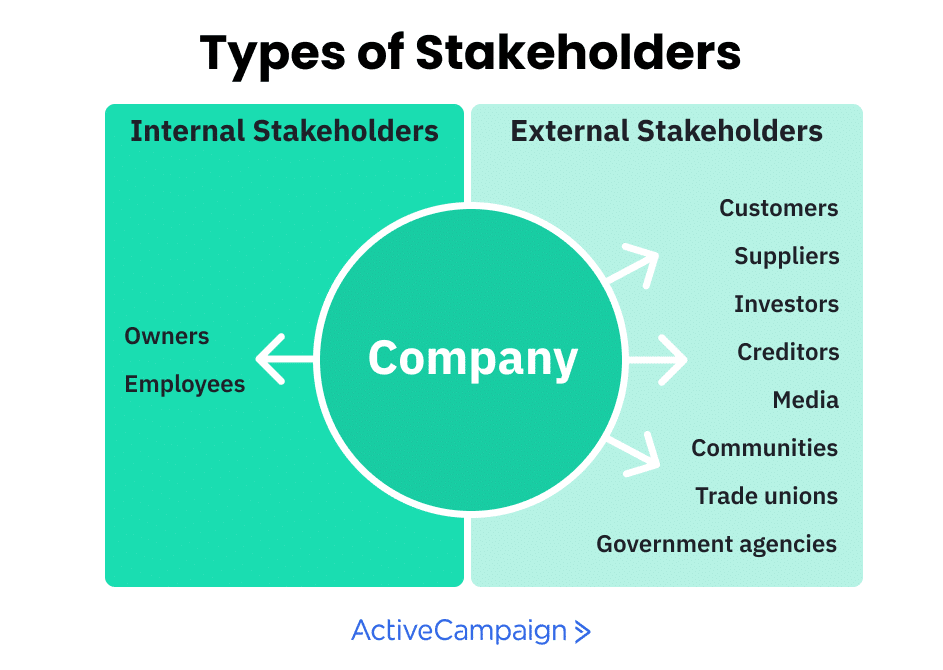
Source: ActiveCampaign
After all, the meeting revolves around keeping them up-to-date and seeking their input.
In terms of the role they play during meetings, their contributions typically include:
- Feedback.
- Validation.
- Acceptance criteria.
- User perspective.
- Decision influencers.
Backlog refinement
Meetings revolving around backlog refinement would only require the participation of the individual responsible for the product backlog.
This can be the product manager, product owner, or scrum master, whichever applies.
Of course, other team members can attend, but they do not need to. That’s why some would say backlog refinement is more of an agile process than an official meeting.
The scrum meeting will commence once these individuals have gathered, following a rather systematic process. The same can be said for all kinds of scrum meetings.
How are scrum meetings conducted?
Sprint planning
A sprint planning meeting would usually involve the following steps:
- The product manager would run through the backlog with the development team. They would explain each item, which often comes as a user story.
- Once the development team has been debriefed on the user story’s purpose, they will break it down into smaller segments. These segments are often actionable tasks.
- The team, including the product manager, would assign priorities to each user story. How they do so may vary, but assigning scores to each one is common practice. The scrum team must agree on a score as a group, a.k.a. unanimously.
- The team must finally decide which user stories to implement for that sprint. They must also determine the amount of time they would put in for each item. These decisions would typically depend on the item’s assigned score.
Daily scrum/standup
The sprint has now started. Every day during the sprint, the team must coordinate and hold daily scrums. To keep it short, it is held in the same place, preferably in a standing circle.
Though the format may vary, it will often involve each member answering three questions:
- What did you accomplish yesterday that contributed to the sprint goal?
- What will you do today that will contribute to the sprint goal?
- Are there any impediments, obstacles, or other issues hindering your progress?
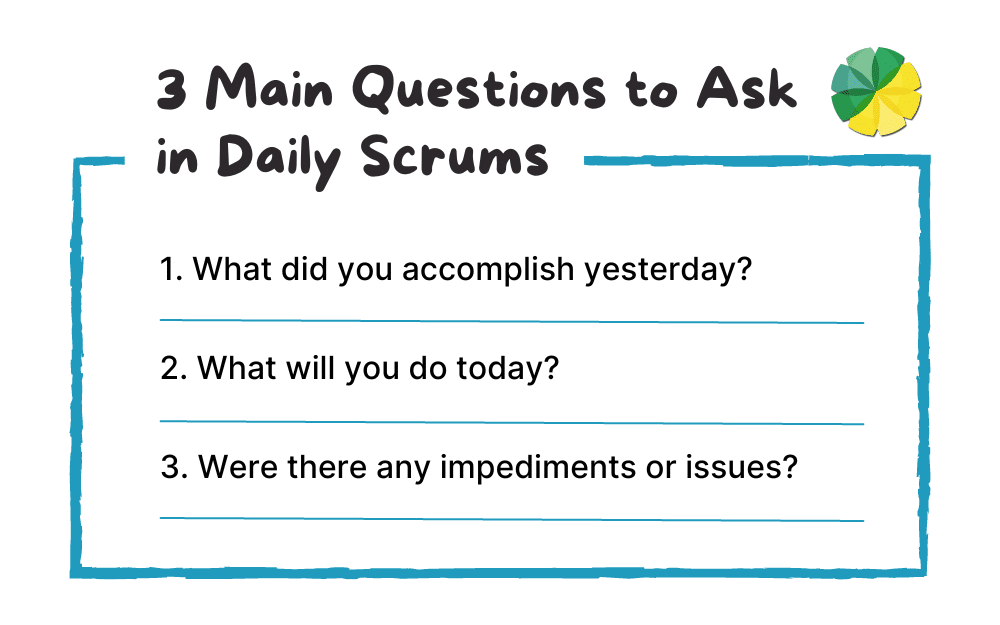
Unlike a sprint planning meeting, there’s no problem-solving involved in this activity.
Of course, some members may provide suggestions to other members with their issues. However, it ultimately revolves around simply informing the team of progress.
Sprint review
Sprint reviews are a more extensive version of one of the daily scrum questions: “What did you accomplish yesterday?”
This time, however, rather than the progress of each member, it involves the progress of the entire scrum team. And instead of what was done yesterday, it concerns what was done for the entirety of the sprint. Demos would be prevalent in this meeting.
For instance, if the team integrates a payment gateway into the platform, they will demonstrate how it works. They will then address any questions the stakeholders may have.
Stakeholders, in this context, may include:
- Beta testers.
- Executives.
- Marketing team.
- Sales team.
- Customer support staff.
If the relevant stakeholders want something to change, those may be included in the product backlog. That way, those new items can be tackled in the succeeding sprints.
Sprint retrospective
The goal of a sprint retrospective is to make it so the team becomes more efficient in the next sprint. It differs from the previous three meetings because it’s not very technical.
It does not revolve around the product, but the team members themselves, particularly:
- Their achievements and areas where they excelled, a.k.a. the positive.
- The challenges, issues, or obstacles they encountered, a.k.a. the negative.
- The root causes of both are to ensure they can repeat successes and avoid failures.

For example, you may discuss how well they communicated during the sprint. You may also talk about their communication issues and how to avoid them.
Backlog refinement
Often, there will be unexpected changes during the project, whether it’s before, during, or after a sprint. For instance, the demand for a specific feature may change.
In that case, the product backlog would need to be refined in response to that change. That’s what backlog refinement “meetings” or discussions are all about.
It’s when you change something, anything at all, in the product backlog.
Though it is less restrictive than most meetings, it must still follow a systematic format which involves the following steps:
- Adding more details, tasks, or subtasks to user stories.
- Reordering the priorities or reassigning scores to user stories.
- Adding entirely new user stories based on new information.
Although this is the typical approach to these meetings, it’s not uncommon for some teams to have a different take. However, the expected outcomes would always remain the same.
What is the expected outcome of a scrum meeting?
#1. Sprint planning
By the end of a sprint planning meeting, the team must have the following:
- An understanding of the sprint objectives or goals.
- A selection of product backlog items to be accomplished in the upcoming sprint.
- Tasks and subtasks for each of the chosen backlog items.
- An estimated timeline to finish each task and subtask.
#2. Daily scrum/standup
Every time a daily scrum meeting ends, the following must already be accomplished:
- An understanding of each team member’s progress yesterday and plans for today.
- An update on the current progress on each task or subtask.
- Any changes resulting from yesterday, such as when a new task is urgently brought up.
- A heads up on the potential issues or hindrances that the team might encounter.
- Suggestions on how to address the issues the team may face, if possible.
#3. Sprint review
The expected outcomes of a sprint review are as follows:
- Stakeholders must clearly understand what has been accomplished during the sprint.
- Validation from stakeholders that the product increment aligns with business objectives.
- A go-signal from stakeholders to mark a user story or task as finished.
- Input or feedback from the relevant stakeholders.
- Changes or updates to the product backlog based on stakeholder feedback.
#4. Sprint retrospective
A sprint retrospective meeting must end with the following outcomes:
- An understanding of what went well during the previous sprint.
- A list of potential improvements to apply in the succeeding sprint.
- An understanding of what went badly during the previous sprint.
- A list of potential impediments to avoid in the succeeding sprint.
#5. Backlog refinement
The outcome of a backlog refinement meeting is much simpler than those of other types of meetings. As the name implies, it must end with a more refined and organised backlog.
It may come in the form of added user stories, tasks, subtasks, and other details. It’s also possible that backlog refinement means removing unnecessary parts from the backlog.
Without these outcomes, the scrum meeting would have been in vain. That’s precisely why there is a need to prepare for these meetings by having a dedicated schedule or timeline.
How often should you conduct scrum meetings?
The schedule for scrum meetings isn’t set in stone.
You can be flexible, but there are limitations. That applies to how often you must hold them and for how long. Here’s an overview of both for each of the five types of scrum meetings.
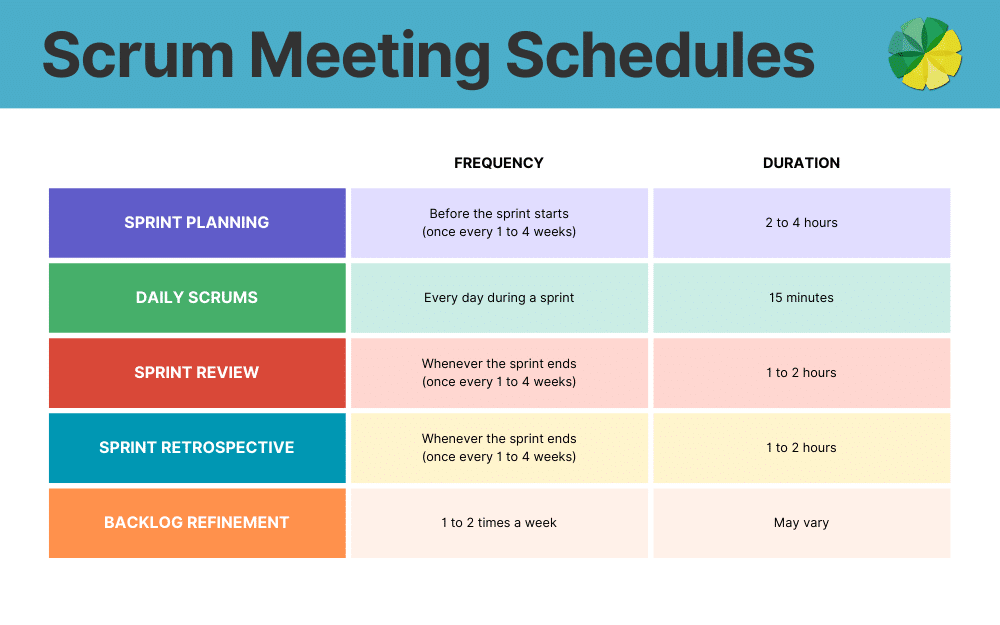
#1. Sprint planning
Frequency
A sprint planning meeting must be held at the beginning of every sprint.
Since sprints may vary in duration, the frequency of such meetings may also vary accordingly. But for reference, it usually ranges from once every 1 to 4 weeks.
Duration
It depends on the complexity or length of the sprint, but 2 to 4 hours is the usual duration.
#2. Daily scrum/standup
Frequency
Daily scrums would be an everyday meeting, but only during a sprint.
Most teams would also meet at the same time and place to avoid confusion.
Duration
Daily scrums are supposed to be short, so 15 minutes is the typical duration.
#3. Sprint review
Frequency
Sprint reviews must be held at the end of every sprint. So, similar to sprint planning, the frequency will depend on the sprints (once every 1-4 weeks).
Duration
This meeting can vary vastly in terms of duration. Though 1 to 2 hours is ideal, it can go for longer if stakeholders are proactive.
#4. Sprint retrospective
Frequency
Sprint retrospectives are held after every sprint review, so their frequency will be the same.
Duration
In most cases, 1 to 2 hours is enough for a retrospective.
#5. Backlog refinement
Frequency
There is no limit to how many times you can conduct backlog refinement meetings.
And unlike daily scrums, it can take place outside of sprints. However, if you want a point of reference, 1 to 2 times a week would be ideal.
Duration
Backlog refinement doesn’t have many restrictions regarding duration. It can vary vastly depending on the number or complexity of changes needed.
Again, there are several ways to conduct meetings. But regardless of your meeting’s format, you’ll find some practices or tips that will always be handy.
5 tips for better scrum meetings
#1. Adhere to time limits strictly
In product development, there is such a thing called a scope. It serves as a compass and prevents development teams from veering away from the intended product design.
Time limits are the same in that it ensures the team stays on topic during meetings.
With a time limit, scrum teams are encouraged to discuss everything that needs to be discussed. Without it, they may get lost and discuss irrelevant topics, hindering progress.
That said, set time limits for each meeting and adhere to them strictly.
#2. Take advantage of specialised tools
With today’s technology, tools specialised in scrum are no longer hard to come by.

Source: Clockify
Platforms like Trello, Jira, and Azure DevOps have features that specifically aid in managing scrum artefacts. These features may range from:
- Backlog management.
- Analytics and reporting.
- Sprint tracking.
- Version history.
It’s only a matter of finding the right tools for your processes. Digital boards, video conferencing apps, and chat platforms are particularly useful for remote teams.
#3. Make use of collaboration tools and platforms
Apart from tools that offer rather technical features, consider productivity tools, particularly those that boost engagement. After all, engagement and motivation highly contribute to better team performance, which leads to better meetings.
Several tools offer such benefits, but gamification is particularly effective in enhancing engagement. Agile gamification has now become a trend.
If you’re interested in incorporating gamification into your agile framework, consider Mambo. The company offers a suite of gamification APIs with all the necessary features.
#4. Limit the attendance
Though it may seem like more people participating is good, it’s often not.
Having more people means more distractions and higher chances of off-topic discussions. It may also make decisions take longer since there’s more input.
Those are just the disadvantages of having one too many attendees.

Source: Gitnux
On the other hand, if there are fewer participants, each team member would feel that their presence is more valuable. As a result, they’re more likely to engage in discussions actively.
That’s not to say you must limit the attendance to only a few people. Rather, you must ensure that only the individuals essential or relevant to the sprint can attend.
Those who aren’t essential to the sprint can receive detailed updates on what happened during the meeting.
#5. Document the scrum meeting
Much like how someone writes court proceedings transcripts, you would benefit from doing the same in scrum meetings. It can be difficult, but it offers numerous benefits:
- Follow-through: Team members typically offer suggestions because they know how to approach them. By documenting the scrum meeting, you make it possible for these team members to follow through with their suggestions or ideas.
- Clarity: The team may encounter scenarios where they wonder why a certain decision was made. For instance, a developer may wonder why a feature wasn’t prioritised despite its importance. Documentation will help clarify such decisions.
- Backup: It’s not uncommon to make mistakes when assigning tasks. In case of a discrepancy, a transcript of your scrum meetings would be the perfect assurance.
4 common mistakes to avoid during scrum meetings
Much like there are tips to maximise scrum meetings, there are also some habits or practices you must avoid. Here are some examples.
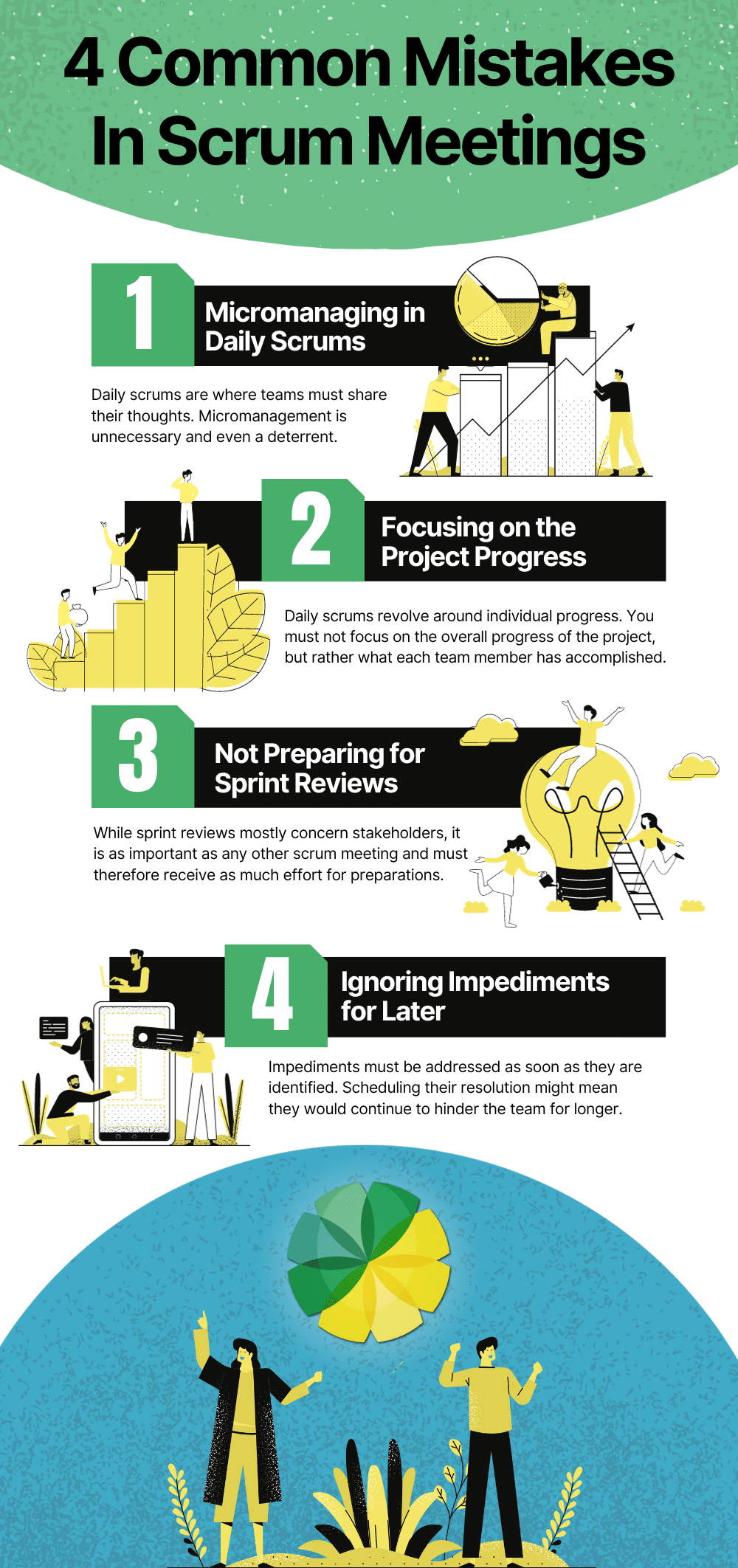
#1. Micromanaging the team during daily scrums
Daily scrums enable team members to share their progress, plans, and thoughts, among many things. It must promote self-organisation and self-management.
That’s why there is no need to micromanage the team during such meetings.
Let the team members speak, and only step in when the discussion is becoming off-topic.
#2. Focusing on the progress of the project
Another common mistake made during daily scrums is talking about the project’s overall progress. This discussion is not meant for daily scrums but rather for sprint planning.
Instead, you must focus on the progress of each team member.
#3. Having little to no preparation for sprint review
Sprint review typically does not affect the team as much as it affects stakeholders. Therefore, it’s not uncommon for scrum teams to put little effort into preparing for the review.
But you must understand that it ultimately affects the team if you cannot showcase the sprint results. There’s a good chance stakeholders may assume the wrong things.
For instance, they may think a feature is not yet implemented when it already is.
When that happens, stakeholders may provide input or feedback about that subject. They may ask that you prioritise it. This will then lead to misunderstandings.
To avoid such issues, communicate properly what you’ve achieved during sprint reviews.
#4. Scheduling solutions for impediments to a later date
It’s not unreasonable to not prioritise certain tasks due to how busy the team currently is.
But that should never happen to impediments. They must be the top priority as soon as they’re identified. Otherwise, it may affect other parts of the sprint backlog later on.
Wrapping up: scrum meeting
It takes a great deal of experience to conduct a scrum meeting efficiently. The good news is these meetings are held regularly, so there are plenty of opportunities to improve. What’s important is that your agile scrum meetings and other activities will improve from here. Reading this guide should be a step towards that goal.
Of course, there are other steps you can take to improve your scrum meetings, or team collaboration, in general. Gamification, for one, is known to enhance engagement.
If you want to boost your team’s motivation, request a demo with Mambo now and see how we can help.
Download your free
“Gamification Guide”
Get your PDF now and start transforming your approach to digital engagement!
Latest Posts
Machine Learning In Finance: 12 Essential Applications
The impact of machine learning on finance is significant. Thanks to this technology, financial institutions are now equipped to make efficient decisions. Through the analysis of data sets, machine learning […]
How To Create Interactive Compliance Training For Bank Employees
Banking compliance training isn’t just another task. It’s the stage where everything else performs. Banks must navigate a myriad of regulations and laws. After all, this is a trust-driven, high-stakes […]
How Fintech Apps Are Using Gamification To Increase User Engagement
Discover how gamification in fintech is revolutionizing financial engagement, making banking fun & boosting user loyalty.





